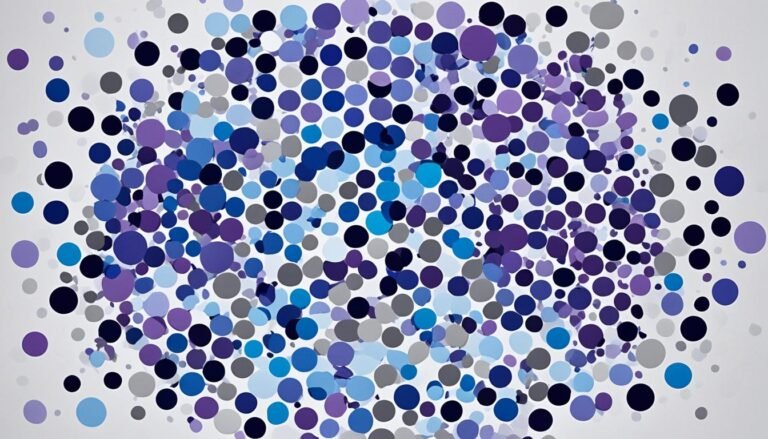What is the number 1 mental illness in the world?
According to the World Health Organization (WHO), the most prevalent mental health conditions globally are anxiety and depressive disorders. These leading psychiatric disorders affect a significant portion of the global population, with approximately 1 in every 8 individuals worldwide experiencing these major mental illnesses. In 2019 alone, an estimated 970 million people were impacted by anxiety and depressive disorders.
Mental disorders encompass a wide range of conditions, including bipolar disorder, post-traumatic stress disorder (PTSD), schizophrenia, eating disorders, and disruptive behavior and dissocial disorders. However, anxiety and depression remain the top mental health concerns worldwide.
Key Takeaways:
- Anxiety and depressive disorders are the most common mental health conditions globally.
- Approximately 1 in every 8 individuals worldwide experience these major mental illnesses.
- Prevalent mental disorders include bipolar disorder, PTSD, schizophrenia, eating disorders, and disruptive behavior and dissocial disorders.
- Access to necessary care for mental disorders is limited, and stigma and discrimination persist.
Anxiety and Depressive Disorders: The Leading Mental Health Concerns
Anxiety disorders and depressive disorders are the most common mental health conditions worldwide, affecting millions of individuals. In 2019, approximately 301 million people experienced anxiety disorders, while 280 million individuals were affected by depressive disorders.
Anxiety disorders manifest as excessive fear and worry, leading to various symptoms. These may include difficulty concentrating, feelings of weakness and fatigue, and general nervousness or fear. People with anxiety disorders often struggle with overwhelming thoughts and emotions, impacting their daily life and overall well-being.
On the other hand, depressive disorders involve a persistent feeling of sadness and a lack of energy. Individuals with depressive disorders may experience changes in appetite, sleep disturbances, and even thoughts of death or suicide. The symptoms of depression can significantly impair one’s ability to function and lead a fulfilling life.
It’s important to note that anxiety and depressive disorders can coexist, leading to more complex and severe symptoms.
Treatment options for anxiety and depressive disorders vary depending on the individual’s needs. Psychotherapy, such as cognitive-behavioral therapy (CBT), can help individuals develop coping mechanisms and address underlying issues. Medications, such as selective serotonin reuptake inhibitors (SSRIs), may also be prescribed in some cases to regulate mood and alleviate symptoms. Additionally, various stress management and relaxation techniques, such as mindfulness and meditation, can provide additional support in managing anxiety and depressive disorders.
Recognizing the signs and symptoms of anxiety and depressive disorders is crucial for early intervention and effective treatment. If you or someone you know is experiencing any of these symptoms, it is important to seek professional help from a mental health provider.
| Anxiety Disorders | Depressive Disorders |
|---|---|
| Blood filling vessels in eyes | Excessive sadness and hopelessness |
| Rapid heart rate and shortness of breath | Loss of interest in previously enjoyed activities |
| Stomachaches and digestive issues | Changes in appetite and weight |
| Irritability and restlessness | Difficulty sleeping or sleeping too much |
| Panic attacks | Feelings of guilt or worthlessness |
Other Major Mental Illnesses Worldwide
In addition to anxiety and depressive disorders, several other major mental illnesses impact individuals worldwide. These conditions can have a profound effect on a person’s daily life and overall well-being. Let’s explore some of these prevalent mental health conditions:
Bipolar Disorder
Bipolar disorder is a complex mental illness characterized by extreme mood swings, ranging from manic episodes marked by elevated energy levels and impulsive behavior to depressive episodes characterized by persistent sadness, loss of interest, and hopelessness. It affects approximately 40 million people globally.
Post-Traumatic Stress Disorder (PTSD)
PTSD is a mental health condition that can develop after experiencing or witnessing a traumatic event. People with PTSD may experience disturbing memories or flashbacks of the event, intense anxiety, nightmares, and a constant state of hypervigilance. It is estimated to affect millions of individuals worldwide.
Schizophrenia
Schizophrenia is a chronic and severe mental disorder that affects how a person thinks, feels, and behaves. It is characterized by hallucinations, delusions, disorganized thinking, and impaired social functioning. It affects roughly 24 million people globally.
Eating Disorders
Eating disorders involve abnormal eating behaviors and distorted perceptions of body weight and shape. Anorexia nervosa, bulimia nervosa, and binge eating disorder are some of the most common eating disorders. These conditions can have severe physical and psychological consequences if left untreated.
Disruptive Behavior and Dissocial Disorders
Disruptive behavior and dissocial disorders encompass a range of conditions characterized by persistent behavior problems that violate societal norms, such as conduct disorder. These disorders often manifest in childhood and can have long-term impacts on a person’s social and emotional well-being.
Effective treatments exist for these conditions, including psychoeducation, medication, and various therapies. Seeking professional help is crucial for individuals affected by these mental illnesses to improve their quality of life and overall functioning.
The Prevalence of Mental Illness in the United States
In the United States, mental illness is a significant public health concern. According to the Centers for Disease Control and Prevention (CDC), approximately 1 in every 5 Americans is currently living with a mental illness. The impact of mental illness in the United States is substantial, affecting individuals of all ages, races, and socioeconomic backgrounds.
When it comes to mental health statistics, anxiety disorders, depression, and post-traumatic stress disorder (PTSD) are among the most common diagnoses in the US. These conditions collectively account for around 30% of all mental health diagnoses.
Individuals with anxiety disorders experience excessive worrying, fear, and uneasiness, often leading to disruptions in their daily lives. Depression, on the other hand, is characterized by persistent feelings of sadness, loss of interest, and a decreased ability to enjoy activities. PTSD is typically a result of experiencing or witnessing a traumatic event, leading to symptoms such as flashbacks, nightmares, and anxiety.
Prevalence of Mental Disorders:
A recent study conducted by the National Institute of Mental Health (NIMH) reported the following prevalence rates for common mental health disorders in the United States:
| Mental Disorder | Prevalence |
|---|---|
| Anxiety Disorders | 19.1% |
| Major Depressive Disorder | 7.8% |
| Post-Traumatic Stress Disorder (PTSD) | 3.6% |
| Bipolar Disorder | 2.8% |
| Schizophrenia | 1.1% |
| Obsessive-Compulsive Disorder (OCD) | 1.2% |
| Eating Disorders | 1.5% |
| Attention-Deficit/Hyperactivity Disorder (ADHD) | 4.4% |
These statistics highlight the alarming prevalence of mental disorders among the American population. It is crucial to address this issue with proactive measures that prioritize mental health awareness, destigmatization, and accessible treatment options.

Conclusion
Mental illness is a widespread global issue that affects individuals in various ways. Anxiety and depressive disorders are among the most prevalent mental health conditions worldwide, impacting millions of people. Additionally, major mental illnesses like bipolar disorder, PTSD, schizophrenia, eating disorders, and disruptive behavior and dissocial disorders significantly affect individuals across the globe.
Despite the existence of effective prevention and treatment options, many individuals facing mental health challenges do not have access to the care they need. Moreover, stigma and discrimination surrounding mental health persist, hindering the progress towards better well-being.
Addressing mental health issues requires a collective effort. It is crucial to increase global mental health awareness, reduce stigma, and advocate for better access to support and treatment for individuals experiencing mental health concerns. By prioritizing mental health and promoting a supportive environment, we can work towards improving the overall well-being of individuals globally.
FAQ
What are the most common mental disorders worldwide?
The most common mental disorders worldwide are anxiety and depressive disorders. These conditions impact approximately 1 in every 8 people globally, totaling around 970 million individuals.
What are the symptoms of anxiety disorders?
Symptoms of anxiety disorders include excessive fear and worry, difficulty concentrating, feeling weak and tired, and a general sense of nervousness or fear.
What are the symptoms of depressive disorders?
Symptoms of depressive disorders include a persistent feeling of sadness, lack of energy, thoughts of death or suicide, and a general feeling of hopelessness.
What other major mental illnesses affect individuals worldwide?
Other major mental illnesses include bipolar disorder, post-traumatic stress disorder (PTSD), schizophrenia, eating disorders, and disruptive behavior and dissocial disorders.
What are the symptoms of bipolar disorder?
Symptoms of bipolar disorder involve alternating depressive episodes with periods of manic symptoms, such as elevated mood, increased energy, and impulsive behavior.
What are the symptoms of PTSD?
Symptoms of post-traumatic stress disorder (PTSD) include vivid flashbacks, avoidance of situations or places associated with the traumatic event, and trouble recalling the experience.
What are the symptoms of schizophrenia?
Symptoms of schizophrenia include significant impairments in perception and behavior, such as hallucinations, delusions, disorganized speech, and social withdrawal.
What are the symptoms of eating disorders?
Symptoms of eating disorders, such as anorexia nervosa and bulimia nervosa, involve abnormal eating behaviors, obsession with body weight and shape, and a distorted body image.
What are disruptive behavior and dissocial disorders?
Disruptive behavior and dissocial disorders, including conduct disorder, involve persistent behavior problems that violate societal norms, such as aggression, theft, and destructiveness.
How common are mental illnesses in the United States?
Approximately 1 in every 5 Americans is currently living with a mental illness, making mental illness a significant public health concern in the United States.
What are the most common mental health diagnoses in the United States?
The most common mental health diagnoses in the United States are anxiety disorders, depression, and post-traumatic stress disorder (PTSD), which make up around 30% of all mental health diagnoses.






